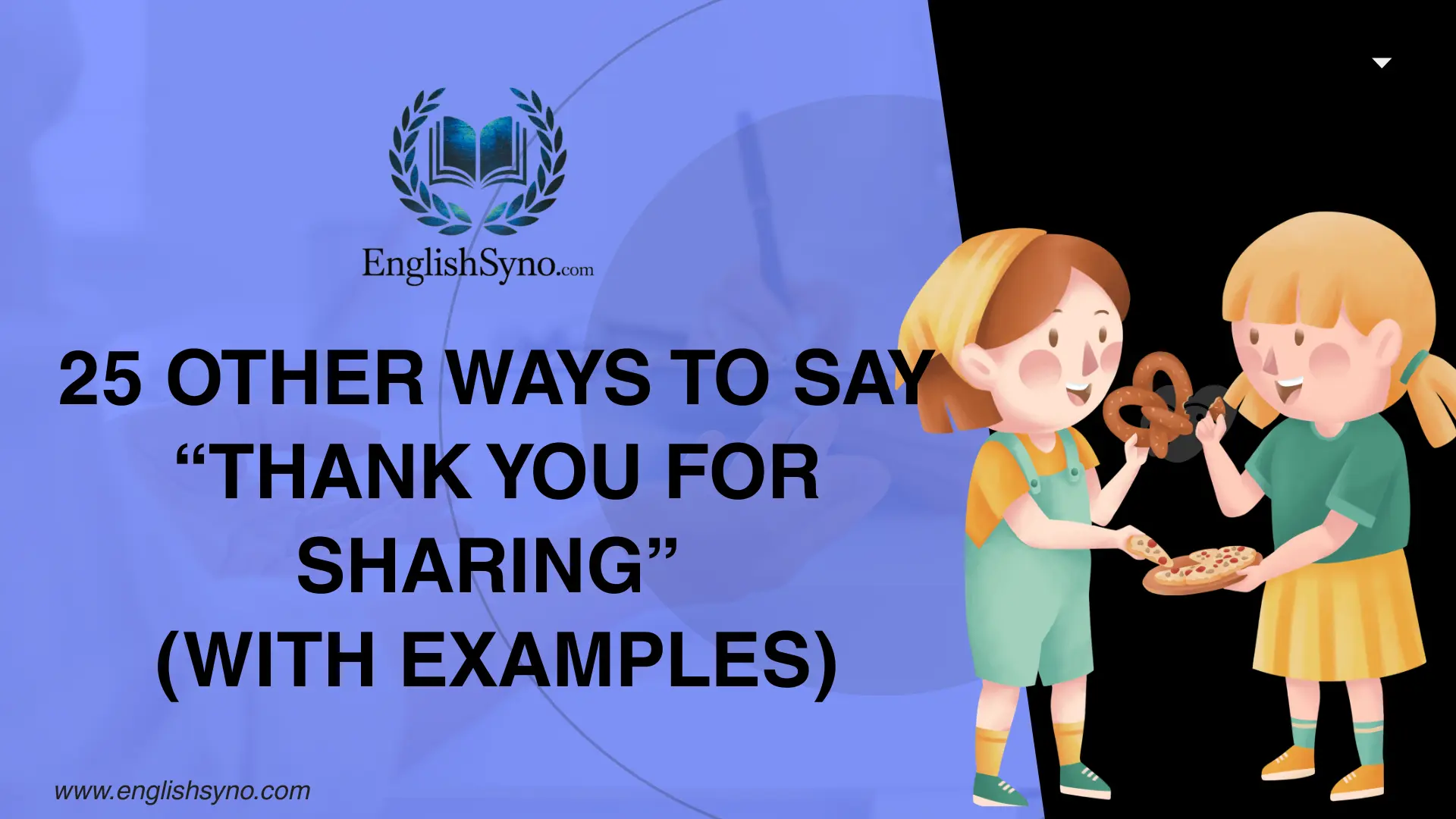When someone has taken the time to share something meaningful, saying thank you for sharing expresses genuine gratitude and appreciation. It often builds trust in professional groups or casual chat, acknowledging their contribution while communicating effectively.
There are nine different ways to say thanks, each with its unique tone, usage, and scenario. Depending on context, appropriateness may vary by situation, types of recipients, correspondents, or communication channel and medium, making the message formal, informal, or warmly natural.
What Does “thank you for sharing” Mean?
Saying thank you for sharing expresses gratitude when someone has shared something meaningful, whether it’s personal thoughts, a story, or helpful information. It acknowledges the effort and value of their contribution while building trust and strengthening relationships.
When to Use “thank you for sharing”
Use thank you for sharing when you want to acknowledge contributions in conversations, emails, chats, or meetings. It’s suitable for professional groups, team discussions, or personal interactions.
Is It Professional/Polite to Say “thank you for sharing”?
Absolutely. Saying thank you for sharing is considered professional and polite, and it strengthens rapport with colleagues, clients, and peers. Depending on the context, it can be formal or informal while remaining respectful.
Pros and Cons
Pros: Builds trust, shows appreciation, encourages open communication, versatile across contexts.
Cons: Can feel repetitive if overused; may seem insincere if not backed by genuine appreciation.
I Appreciate You Sharing This
Meaning/Definition: Expresses gratitude directly while highlighting the importance of the shared information.
Example: “I appreciate you sharing this update; it gives our team a clear picture of the situation.”
Best Use: When the information is valuable or clarifying.
Worst Use: When the content is trivial.
Tone: Warm, professional, sincere
Thanks for Letting Me Know
Meaning/Definition: A casual, friendly way to acknowledge that someone has provided useful information.
Example: “Thanks for letting me know about the schedule change; I’ll adjust my plans accordingly.”
Best Use: Quick updates, informal messages.
Worst Use: When a formal acknowledgment is required.
Tone: Casual, polite
I’m Grateful for Your Input
Meaning/Definition: Highlights gratitude for someone’s ideas, feedback, or contribution.
Example: “I’m grateful for your input on the report; it helped me see things from a new perspective.”
Best Use: Meetings, feedback sessions, collaborative work.
Worst Use: When input is negligible or insincere.
Tone: Professional, thoughtful
I Value Your Perspective
Meaning/Definition: Shows that you appreciate the unique viewpoint or insight someone has shared.
Example: “I value your perspective on this issue; it helps me consider options I hadn’t thought of.”
Best Use: When someone provides thoughtful input.
Worst Use: When the input is minimal or irrelevant.
Tone: Respectful, appreciative
Thank You for the Insight
Meaning/Definition: Highlights appreciation for informative or enlightening content shared by someone.
Example: “Thank you for the insight regarding the market trends; it really clarified our strategy.”
Best Use: Professional discussions, strategy meetings.
Worst Use: Casual or trivial comments.
Tone: Formal, professional
I Appreciate Your Thoughts
Meaning/Definition: Acknowledges that someone’s personal thoughts are valued.
Example: “I appreciate your thoughts on the proposal; your feedback is really helpful.”
Best Use: Personal and professional feedback.
Worst Use: When input is superficial.
Tone: Warm, respectful
Your Contribution Means a Lot
Meaning/Definition: Emphasizes the importance of what someone has contributed.
Example: “Your contribution means a lot to the success of this project.”
Best Use: Teamwork and collaboration recognition.
Worst Use: For small or inconsequential contributions.
Tone: Sincere, motivating
Grateful for Your Input
Meaning/Definition: Expresses thanks for feedback, advice, or information provided.
Example: “Grateful for your input on the client presentation; it made our pitch stronger.”
Best Use: Professional reviews or personal guidance.
Worst Use: Casual conversations with minor input.
Tone: Professional, appreciative
Thanks for Sharing Your Experience
Meaning/Definition: Acknowledges someone’s personal story or real-life experience.
Example: “Thanks for sharing your experience; it gave me a new perspective on handling similar situations.”
Best Use: Mentorship, storytelling sessions, peer learning.
Worst Use: Overly generic sharing.
Tone: Warm, empathetic
I Appreciate the Details You Provided
Meaning/Definition: Highlights gratitude for thorough and specific information shared.
Example: “I appreciate the details you provided; they clarified many of my questions.”
Best Use: Reports, research, or data-heavy communications.
Worst Use: When information is vague.
Tone: Professional, respectful
Thank You for the Update
Meaning/Definition: Shows gratitude for receiving current or timely information.
Example: “Thank you for the update on the project timeline; it helps us stay on track.”
Best Use: Email updates, project tracking.
Worst Use: When information is not relevant.
Tone: Polite, professional
I Value What You Shared
Meaning/Definition: Acknowledges and appreciates the shared information or viewpoint.
Example: “I value what you shared during the meeting; it helped me make a better decision.”
Best Use: Team discussions, feedback sessions.
Worst Use: When sharing is minimal or unhelpful.
Tone: Respectful, thoughtful
I’m Thankful for Your Thoughts
Meaning/Definition: Expresses gratitude for personal ideas or reflections.
Example: “I’m thankful for your thoughts on the project; they brought clarity to our approach.”
Best Use: Brainstorming, personal feedback.
Worst Use: Generic or forced gratitude.
Tone: Warm, genuine
Thanks for Your Contribution
Meaning/Definition: Recognizes the effort someone put into sharing knowledge or resources.
Example: “Thanks for your contribution to the report; it strengthened the final presentation.”
Best Use: Teamwork, collaboration, shared projects.
Worst Use: Minimal or minor participation.
Tone: Appreciative, professional
I Appreciate Your Effort
Meaning/Definition: Shows gratitude for someone’s time, thought, or energy in sharing information.
Example: “I appreciate your effort in compiling these documents; they’re very helpful.”
Best Use: When someone invested significant effort.
Worst Use: For trivial tasks.
Tone: Sincere, professional
Thank You for Bringing This Up
Meaning/Definition: Expresses thanks when someone raises a useful point or topic.
Example: “Thank you for bringing this up during the meeting; it’s an important point to consider.”
Best Use: Meetings, discussions, brainstorming.
Worst Use: When the point is irrelevant.
Tone: Polite, professional
I Appreciate Your Clarification
Meaning/Definition: Thanks to someone for making something clear or removing confusion.
Example: “I appreciate your clarification on the schedule; now we can plan efficiently.”
Best Use: When confusion or ambiguity exists.
Worst Use: When information is obvious.
Tone: Respectful, professional
Thanks for Your Guidance
Meaning/Definition: Shows gratitude for advice, mentorship, or direction provided.
Example: “Thanks for your guidance on this project; it really helped me focus.”
Best Use: Mentorship, coaching, or leadership support.
Worst Use: When guidance is generic or irrelevant.
Tone: Respectful, warm
I Appreciate Your Feedback
Meaning/Definition: Expresses gratitude for constructive criticism or suggestions.
Example: “I appreciate your feedback on the draft; it helped me improve it significantly.”
Best Use: Reviews, revisions, and evaluations.
Worst Use: When feedback is trivial.
Tone: Professional, thoughtful
Thank You for Your Time
Meaning/Definition: Acknowledges the time someone dedicated to sharing information or advice.
Example: “Thank you for your time in reviewing this; it’s greatly appreciated.”
Best Use: Emails, meetings, consultations.
Worst Use: Overused for small tasks.
Tone: Polite, professional
I Appreciate Your Perspective
Meaning/Definition: Expresses gratitude for someone’s point of view or opinion.
Example: “I appreciate your perspective on this decision; it helped me see a different angle.”
Best Use: Discussions, brainstorming sessions.
Worst Use: When perspective is minimal or unhelpful.
Tone: Respectful, thoughtful
Thanks for Your Suggestion
Meaning/Definition: Shows gratitude for ideas or recommendations shared.
Example: “Thanks for your suggestion regarding the workflow; it made the process smoother.”
Best Use: Professional and casual suggestions.
Worst Use: When suggestions are irrelevant.
Tone: Polite, constructive
I’m Grateful for Your Help
Meaning/Definition: Expresses gratitude for assistance or support given.
Example: “I’m grateful for your help in preparing the presentation; it made a big difference.”
Best Use: Teamwork, collaborative efforts.
Worst Use: Overused for small actions.
Tone: Warm, sincere
Thank You for Your Input
Meaning/Definition: Recognizes and appreciates someone’s contribution or ideas.
Example: “Thank you for your input during the discussion; it helped us reach a better decision.”
Best Use: Meetings, decision-making, collaborative tasks.
Worst Use: For minor or irrelevant input.
Tone: Professional, polite
I Appreciate You Sharing This
Meaning/Definition: Expresses gratitude for the shared information, emphasizing its value.
Example: “I appreciate you sharing this article; it gave me great insights into the topic.”
Best Use: When information or resources are meaningful.
Worst Use: When the shared item is trivial.
Tone: Warm, appreciative
Final Thoughts
Expressing gratitude is a simple yet powerful way to strengthen relationships, build trust, and show appreciation for the contributions of others. Saying thank you for sharing or its alternatives not only acknowledges the effort someone has made but also communicates warmth, sincerity, and respect. In professional and personal contexts, using thoughtful expressions of gratitude can make a message feel more personal, meaningful, and impactful.
By exploring various ways to say thank you for sharing, you allow your interactions to adapt to different scenarios, whether in meetings, casual chats, emails, or mentoring sessions. Some phrases are formal, perfect for professional correspondence, while others are casual and suitable for friendly conversations. Understanding the context, the recipient, and the tone you want to convey ensures that your gratitude resonates effectively.
Furthermore, thoughtful acknowledgment encourages open communication and motivates people to share more ideas, insights, and experiences. It demonstrates that you value not only the content but also the person behind it. Using alternatives to thank you for sharing can help prevent your expressions from sounding repetitive or insincere.
Ultimately, mastering the art of expressing gratitude is about choosing words that genuinely reflect your appreciation. Each of the 25 alternatives discussed provides a unique way to communicate respect, recognition, and warmth. By practicing these phrases, you can cultivate meaningful connections, enhance collaboration, and foster a positive environment both personally and professionally. Remember, sincere appreciation never goes unnoticed, and even small words of gratitude can leave a lasting impression.
Frequently Asked Questions (FAQs)
What does “thank you for sharing” mean?
It is a polite way to express gratitude when someone provides information, insights, or personal experiences, acknowledging their effort and contribution.
When should I use “thank you for sharing”?
Use it in professional emails, team meetings, casual chats, or any situation where someone has shared meaningful or helpful information.
Is “thank you for sharing” formal or informal?
It can be both. It is polite and professional but also warm and suitable for casual conversations, depending on tone and context.
Can I use alternatives instead of “thank you for sharing”?
Yes. Alternatives like “I appreciate your input” or “Thanks for letting me know” add variety and can feel more personal and sincere.
How does it affect relationships?
Expressing gratitude builds trust, strengthens connections, encourages open communication, and motivates people to share more ideas and insights.
Are there professional benefits to using this phrase?
Yes. In workplaces, it shows respect, acknowledges effort, and fosters a collaborative and positive environment.
Can it be overused?
Overuse may make it seem insincere. Use it genuinely and vary phrases to maintain authenticity.
Does it work in emails?
Absolutely. It is effective in both formal and informal email correspondence to acknowledge contributions.
How can I make it sound more personal?
Include specifics about what was shared, such as “Thank you for sharing your ideas on the project timeline.”
Is it suitable for mentoring relationships?
Yes. It encourages mentees to share thoughts and shows appreciation for their perspective and effort.
Can it be used in presentations?
Yes. Acknowledging audience contributions during discussions or Q&A sessions fosters engagement and shows respect.
How do cultural differences affect usage?
Some cultures may prefer formal acknowledgment, while others respond well to casual expressions of gratitude. Adjust tone accordingly.
Can I use it in social media comments?
Yes. It is a polite and encouraging way to acknowledge content shared publicly, fostering positive interaction.
What tone should I use?
Use warm, sincere, and professional tones depending on context; casual for friends, formal for workplace communications.
Are there risks in using it incorrectly?
If used insincerely or inappropriately, it may come off as robotic or flippant. Always tailor to context and audience.



